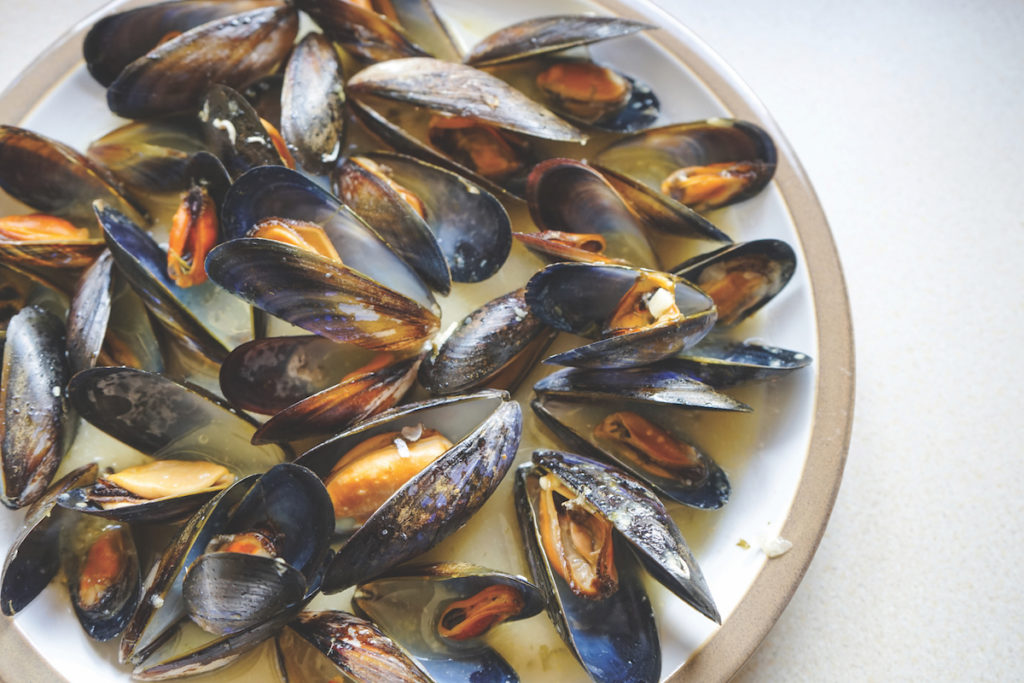
The mussel stew we’ve been enjoying forever is a good one: Portuguese-style with linguiça, peppers, onions, and tomatoes. A Cape Cod staple. But over the years we’ve tinkered with the recipe, going for a little more richness, a little more heat and smoke, and, especially when making it in winter, a remembrance of summer herbs.
Gradually, we’ve ended up with a version that has the complexity, flavor-wise, of a dish you’d want to make for special occasions. That, and the nonchalant cooking commitment of 20 minutes that suits any of us who are committed to the attention requirements of this year’s bad-news-that-knows-no-bounds.
In all, here is a pot of mussels that’s perfect for this New Year’s Eve.
Even though in our household we call these “Truro mussels” — they’re the ones we make as a way of settling in when we arrive from Boston to the house we share here — they start with mussels from Eastham.
Unlike the widely available farmed mussels from Prince Edward Island, which are small, uniform, and almost tasteless, Eastham mussels are plump and fresh with complex flavors of the sea. They are harvested wild, year-round, in the Nauset estuary. You can tell by their substantial beards that these are the real deal.
Andouille sausages, if you can find them (say, on an excursion to the butcher shop at Nauset Farms in East Orleans), make for a more intense complement to the mussels than ordinary chourizo or linguiça do. And the local mussels can hold their own against the smoke, red and black pepper, and thyme seasonings in the sausage. Besides the andouille, you’ll notice that this recipe relies on both olive oil and butter.
Our other variation is the addition of anise flavors. Half a fennel bulb sliced thin and then chopped fine plus a good-size splash of Pernod work wonders to enhance the flavors of both the mussels and the sausage. If you’re not already into Pernod, you are going to look at that $30 bottle and wonder how you’re ever going to use it up. I promise you that once you try it in these mussels, you’ll be adding it to every seafood stew you make.
And after some trial and error with a little wine or clam or chicken broth in this, we realized that, for a mussel stew that creates plenty of rich broth, we needed no additional liquid. Just the natural juices of the Eastham mussels plus the juices from the fennel and the onion are plenty. Not only plenty, but best.
A heavy pot with a tight-fitting lid is part of the alchemy with this soup. Le Crueset is ideal.
After sautéing the soft mash made from the onions and the fennel, toss in the sausage, then the cleaned mussels plus a splash of Pernod, and clamp down the top on the heavy pot. Eight minutes later, you have not only mussels, but soup. If you want to be really fancy, you can get rid of most of the shells after they cook, arranging just a few symbolic ones on top.
Some people might add a dab of cream or crème fraîche and a bit of mustard — those are classics in French versions of steamed mussels. But we find this mussel soup is plenty rich and flavorful as is. Still, the recipe is forgiving of experiment and variation. It is never quite the same twice, anyway.
There is one perfect complement you shouldn’t skip: lightly toasted sourdough bread.
Truro Eastham Mussels
Serves two as a main or four as a starter
3 lbs. Eastham mussels
1 medium onion
Half a fennel bulb
1/3 cup Pernod
2 Tbsp. olive oil
2 Tbsp. butter
1 andouille sausage
Rinse and debeard the mussels. Dice the onion and the fennel. Cut the sausage into thin coins and cut each in half.
Warm the oil and butter in a heavy pot with a tight-fitting lid. Sauté fennel over low to medium heat about 7 minutes. Add onion, sauté 5 more minutes. Stir in sausage. Add Pernod. Simmer 4 more minutes until the vegetables are very soft.
Add mussels. Do not add any more liquid. Cover and cook at medium heat for 8 minutes. If you want to be elegant, remove shells.
You will have a stew with broth that is entirely from the mussels. Serve with lightly toasted sourdough bread.



